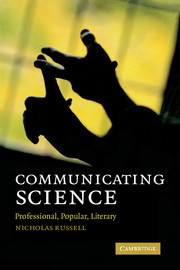Book contents
- Frontmatter
- Contents
- Introduction: What this book is about and why you might want to read it
- Prologue: Three orphans share a common paternity: professional science communication, popular journalism and literary fiction are not as separate as they seem
- Part I Professional science communication
- Part II Science for the public: what science do people need and how might they get it?
- Part III Popular science communication: the press and broadcasting
- 10 What every scientist should know about the mass media
- 11 What every scientist should know about journalists
- 12 The influence of new media
- 13 How the media represent science
- 14 How should science journalists behave?
- Part IV The origins of science in cultural context: five historic dramas
- Part V Science in literature
- Index
- References
13 - How the media represent science
Published online by Cambridge University Press: 02 December 2010
- Frontmatter
- Contents
- Introduction: What this book is about and why you might want to read it
- Prologue: Three orphans share a common paternity: professional science communication, popular journalism and literary fiction are not as separate as they seem
- Part I Professional science communication
- Part II Science for the public: what science do people need and how might they get it?
- Part III Popular science communication: the press and broadcasting
- 10 What every scientist should know about the mass media
- 11 What every scientist should know about journalists
- 12 The influence of new media
- 13 How the media represent science
- 14 How should science journalists behave?
- Part IV The origins of science in cultural context: five historic dramas
- Part V Science in literature
- Index
- References
Summary
Professor Janet Docherty was smart, personable, articulate and running an important cell biology research group investigating the behaviour of cell lines taken from mouse cancers. She had no trouble getting research grants; she was a star at conferences, and eligible for election to the Royal Society. The organizations funding her and her university were keen to publicize her work and Janet herself was perfectly willing to do all that she could in talking to the media.
The press liaison offices at her university and at a leading research charity tried to build news stories round her best papers. Press releases were carefully drafted; press conferences organized at prestigious London venues, the press officers and Janet herself were careful to get to know the leading science and health correspondents personally and always to respond to requests from journalists for interview. Janet was the very model of a modern media-savvy professor and her labours and those of her press officers were rewarded, her work always attracted interest and a certain amount of low key coverage. But media attention did not reflect her professional status as a leading cancer researcher.
Then, one day in a faraway corporate laboratory in a rustbelt American city a small team announced a breakthrough in the treatment of lung cancer, a drug which might stop one of the most intractable cancers of all. It worked in rodents, but still had to go through the whole series of clinical trials in humans. Announcing it at this stage was a huge risk for the pharmaceutical company concerned but it was small, in need of more investment, and generated the publicity to attract it. […]
- Type
- Chapter
- Information
- Communicating ScienceProfessional, Popular, Literary, pp. 172 - 189Publisher: Cambridge University PressPrint publication year: 2009



